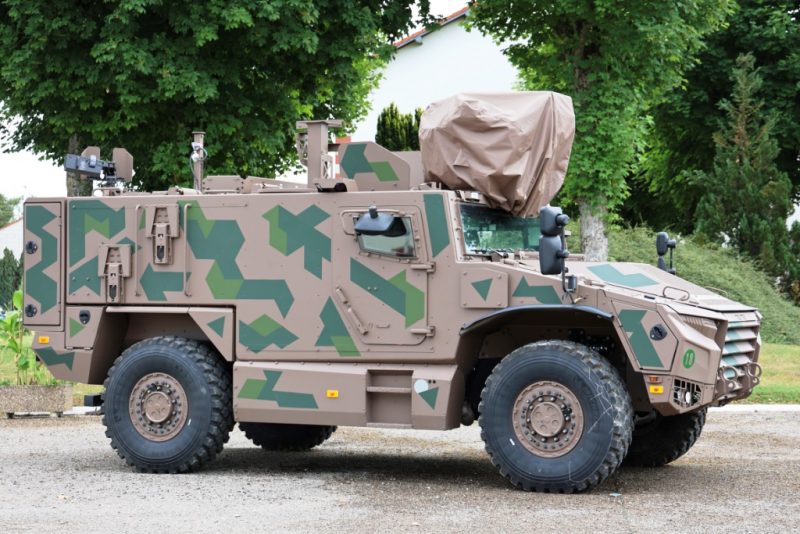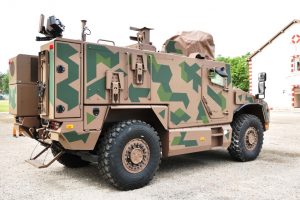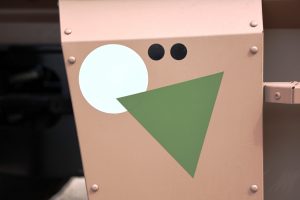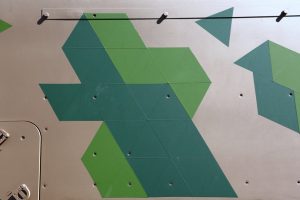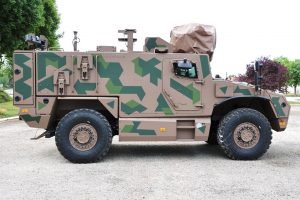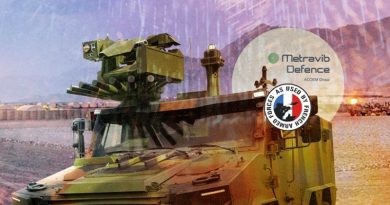The French Army unveils its new CAM.TAC camouflage scheme on the VBMRL Serval
The implementation of the SCORPION programme and the related armoured vehicles that are currently being fielded led the French Army to finally adopt a new camouflage scheme, which was unchanged since the CAM.86. The new CAM.TAC was finally unveiled during an event at the camp of Mourmelon, shown on the VBMRL Serval
The CAPCIA 51 RI (Centre d’Appui et de Préparation au Combat InterArmes – 51e Régiment d’Infanterie, Combined Arms Combat Support and Preparation Centre – 51st Infantry Regiment) based on the camp of Mourmelon le Grand, some 150 km west-north-west of Paris, hosted the unveiling of the new French Army CAM.TAC (Tactical Camouflage) that was shown on a VBMRL (Véhicule Blindé Multi-Rôle Léger), the 4×4 vehicle produced by Nexter and Texelis now in service with the French Armée de Terre.
The new scheme, which aims at improving stealth and concealment, but also represents the new identity signature of the Army, was illustrated by officers of the COMMF (Commandement de la Maintenance des Force, Forces Maintenance Command) and of the STAT (Section Technique de l’Armée de Terre, the Army Technical Section).
The project was initiated by the STAT in partnership with the DGA (Direction Générale de l’Armement, General Directorate of Armament) and the SIMMT (Structure Intégrée du Maintien en condition opérationnelle des Matériels Terrestres, the Integrated Support Structure for Land Forces Equipment And Systems).
The new camouflage scheme is primarily intended for front line equipment that is currently sporting the “Terre de France” brown single-colour camouflage. In due time the new scheme will be adopted on all vehicles. The new CAM.TAC presented at Mourmelon is exclusively made of sections of equilateral triangles assembled together, to form segmented geometric compositions in order to break the vehicle shape. Although geometric shapes have no place in a natural setting, with distance the angles become blurred and gain in stealth, increasing aiming time when using optical and optronic detection systems. A few isolated spots called “chaos spots” complete the disruptive pattern.
Three theaters of operations were selected:
• European camouflage, made up of two tones of green. The so-called black spruce green, and the dark green, inherited from the former Center Europe camouflage which proved effective in the past.
• Desert camouflage, alternating two shades of brown, medium and light.
• The snow camouflage that adds white and gray, already listed in the Norm. Def. 001, the then Ministry of Defence document titled “Colours for the French Ministry of Defence” and first published in March 2009.
• No urban camouflage is envisaged.
All new vehicles delivered by manufacturers will display the new European CAM.TAC directly at the factory and in the form of final paint (at Mourmelon green patches were stickers). The major advantage of this patchwork is its ease of reversibility and adaptation to rapid deployment in another theater of operation.
Like MAT2636 (French army camouflage and markings manual), precise and specific application and distribution diagrams for each machine will be provided, to adapt to the requested reversibility and replacement with removable stickers that will be superposed over green colours. The CAM.TAC does not foresee any change in the percentage of camouflage to achieve depending on the theater, the scheme remains identical and in accordance with the manual, and only colours change.
This operation will be carried out by the crew itself using adaptation kits provided for each vehicle, within a contractually agreed time of four hours. According to information gathered by EDR On-Line, it seems possible to halve the time required to glue stickers on a complete vehicle.
Compared to the CAM.86, black has been definitely abandoned. Although it was effective at breaking shapes, its heat absorbing characteristic generated a heat signature that was showing up too much on thermal imagers.
For the equipment already in service, once repainted in the Terre de France brown colour, it will be the SIMMT that will add the new European patches in its paint shops. The static camouflage is completed by the ECR (Ecran de Camouflage Rapide – Quick Camouflage Screen) a camouflage net provided in the base Terre de France brown shade. The adoption of ECRs with printed geometric camouflage is under consideration.
The resistance and the application of the colour patches was tested in different climatic conditions, hot, cold, and humid. Decontamination, undergrowth tearing, transfer of glue, were also evaluated and are submitted as constraints to industrial suppliers.
The tires are also a source of thermal signature to be taken into account as it shows brightly on thermal imagers. Other nations experienced flexible side plates or sidewall painting, and such systems proposed by some manufacturers might be considered as camouflage solutions. Currently tires camouflage still relies on dust and mud as well as on ECRs, and no specific technical project has yet been considered to solve this issue.
On July 14, 2023, on the occasion of the French National Day, the new camouflage scheme will be shown for the first time to the general public, applied to over 30 SCORPION vehicles, which will parade on the avenue des Champs Elysées in Paris.
Such a reversible camouflage scheme increases flexibility as well as the ease of realization and modification, which results in a significant drop in paint costs. A real turning point for the Army, which marks with a new identity its entry into the 21st century deploying a range of modern and innovative SCORPION combat vehicles.
Photos by J- Hadacek

